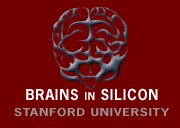Neuroprosthesis: Fully implanted brain-machine interfaces
BrainGate's partially implanted brain machine interface (BMI) uses half of the 100 mW it consumes to wirelessly transmit neural signals recorded on 100 microelectrodes. Most of this energy could be saved by processing these signals inside the implant to decode the intended movement. We are exploring a neuromorphic approach to perform this processing energy-efficiently. Our approach mimics the brain's graded dendritic potentials using analog circuits and its all-or-none axonal spikes using digital circuits, thereby combining energy-efficient analog computation with software-configurable digital communication.
We use the Neural Engineering Framework (NEF) to configure our mixed analog-digital neuromorphic chips.
Developed by Eliasmith and Anderson, NEF defines three principles of neural computation. First, a population of neurons collectively represents a time-varying vector through nonlinear encoding and linear decoding. Second, alternative linear decodings that transform this vector (linearly or nonlinearly) are used to compute weighted connections from one neural population to the next. Third, recurrent connections—from a neural population back to itself—realize a transformation that governs the vector's dynamics.
The first spiking neural network, consisting of two populations with 1000 spiking neurons each, decoded spike trains recorded from the motor cortex (into intended movement) as accurately as a MatLab implementation of the Kalman-filter algorithm on which it was based. The second one, consisting of five populations with 256 spiking neurons each, controlled a three-degree-of-freedom robot-arm with a precision of 1.3 to 2.1 cm. To ensure safety, the end-effector's force—rather than its position—is controlled. This force-based approach makes the robot compliant to external perturbations (see video). An entire BMI may be realized by combining these two networks, which Brainstorm will run using only a few microwatts.We have used NEF to implement a Kalman-Filter-based decoder with simulated spiking neurons as well as to implement a robot-arm controller with silicon spiking neurons.
Students & Postdocs
Sam Fok is prototyping robot-arm controllers on Neurogrid.
Samir Menon is building articulated robots and exploring force-based control.
Paul Nuyujukian is testing BMI decoders and robot-arm controllers in the clinic.
Collaborators
Oussama Khatib
Krishna Shenoy
Jaimie Henderson
Funding
National Institutes of Health
Office of Naval Research
Stanford Neurosciences Institute
| ID | Article | Full Text |
|---|---|---|
| C42 | S Menon, S Fok, A Neckar, O Khatib, and K Boahen, Controlling Articulated Robots in Task-Space with Spiking Silicon Neurons, IEEE International Conference on Biomedical Robotics and Biomechatronics (BioRob), IEEE Press, pp nn-mm, 2014. | Full Text |
| C39 | J Dethier, P Nuyujukian, C Eliasmith, T Stewart, S A Elassaad, K V Shenoy, and K Boahen, A Brain-Machine Interface Operating with a Real-Time Spiking Neural Network Control Algorithm, Advances in Neural Information Processing Systems 24, Curran Associates, Inc., pp 2213-21, 2011. | Full Text |
| C38 | J Dethier, V Gilja, P Nuyujukian, S A Elassaad, K V Shenoy, and K Boahen, Spiking Neural Network Decoder for Brain-Machine Interfaces, IEEE EMBS Conference on Neural Engineering, IEEE Press, pp 369-399, 2011. | Full Text |
| J38 | J Dethier, P Nuyujukian, S I Ryu, K V Shenoy, and K A Boahen, Design and validation of a real-time spiking-neural-network decoder for brain machine interfaces, Journal of Neural Engineering. Vol 10, p. 036008, Apr 2012 | Full Text |

